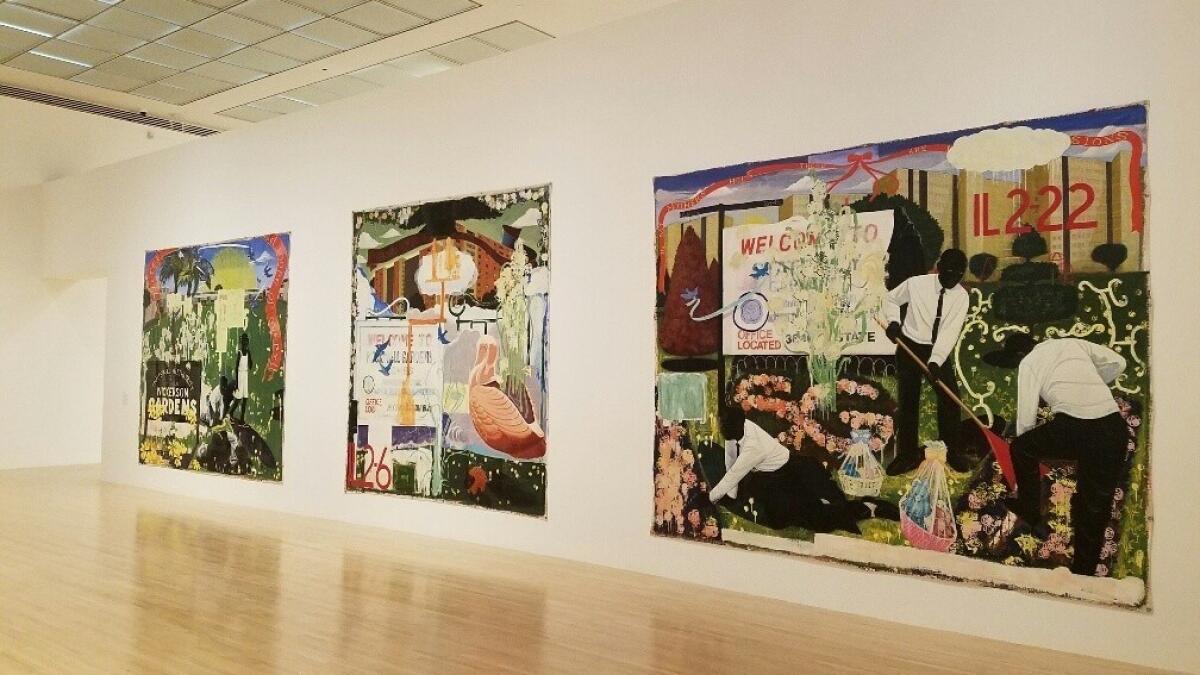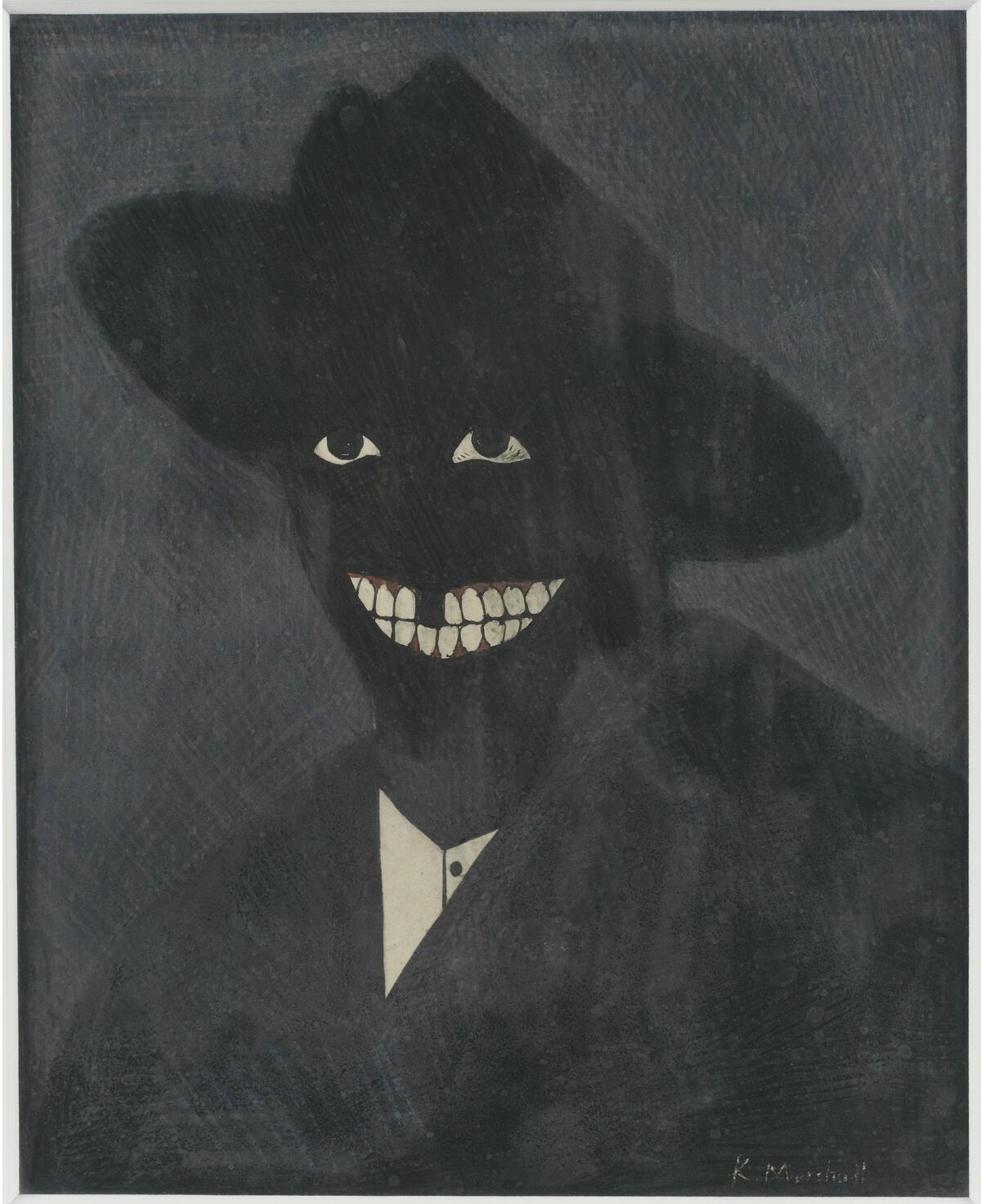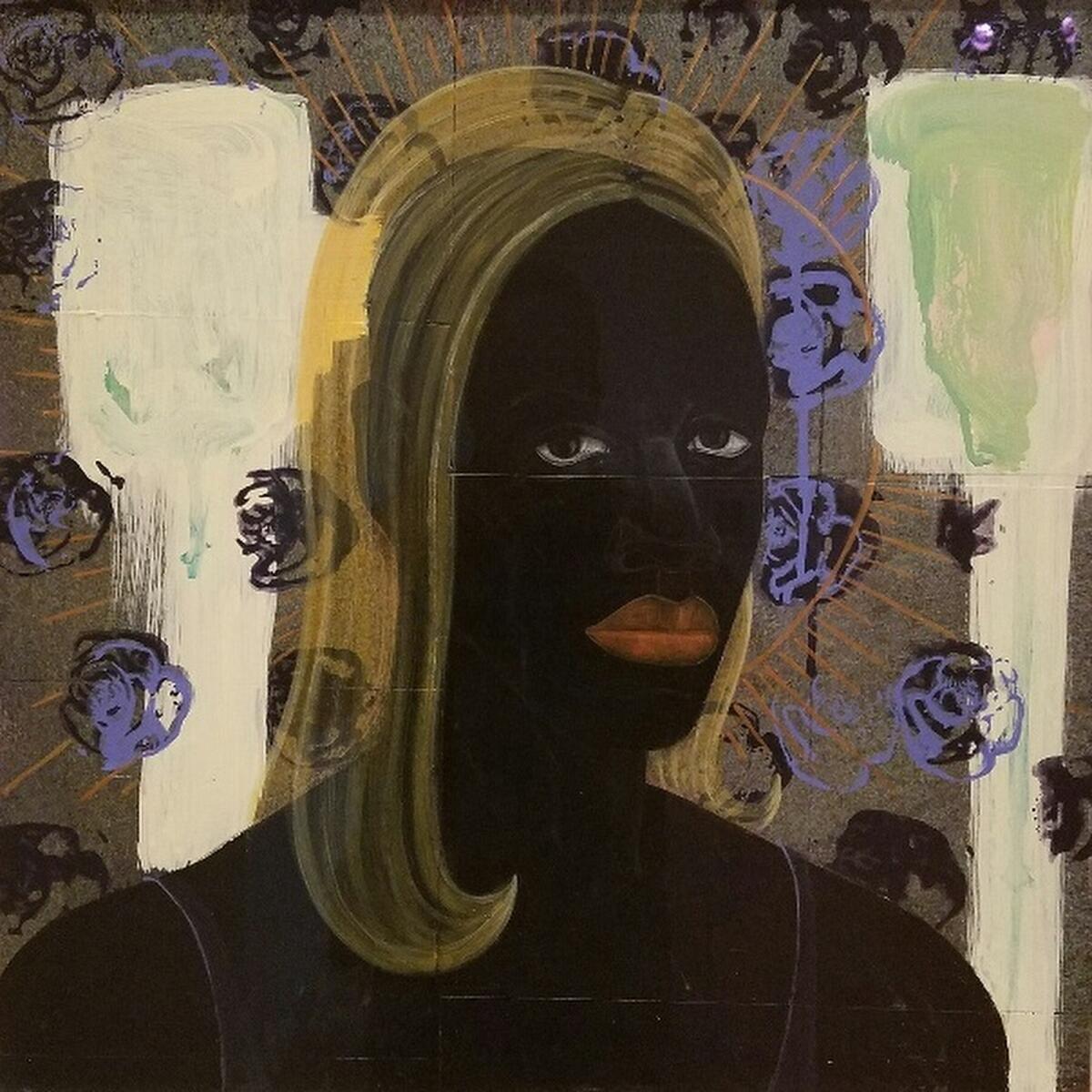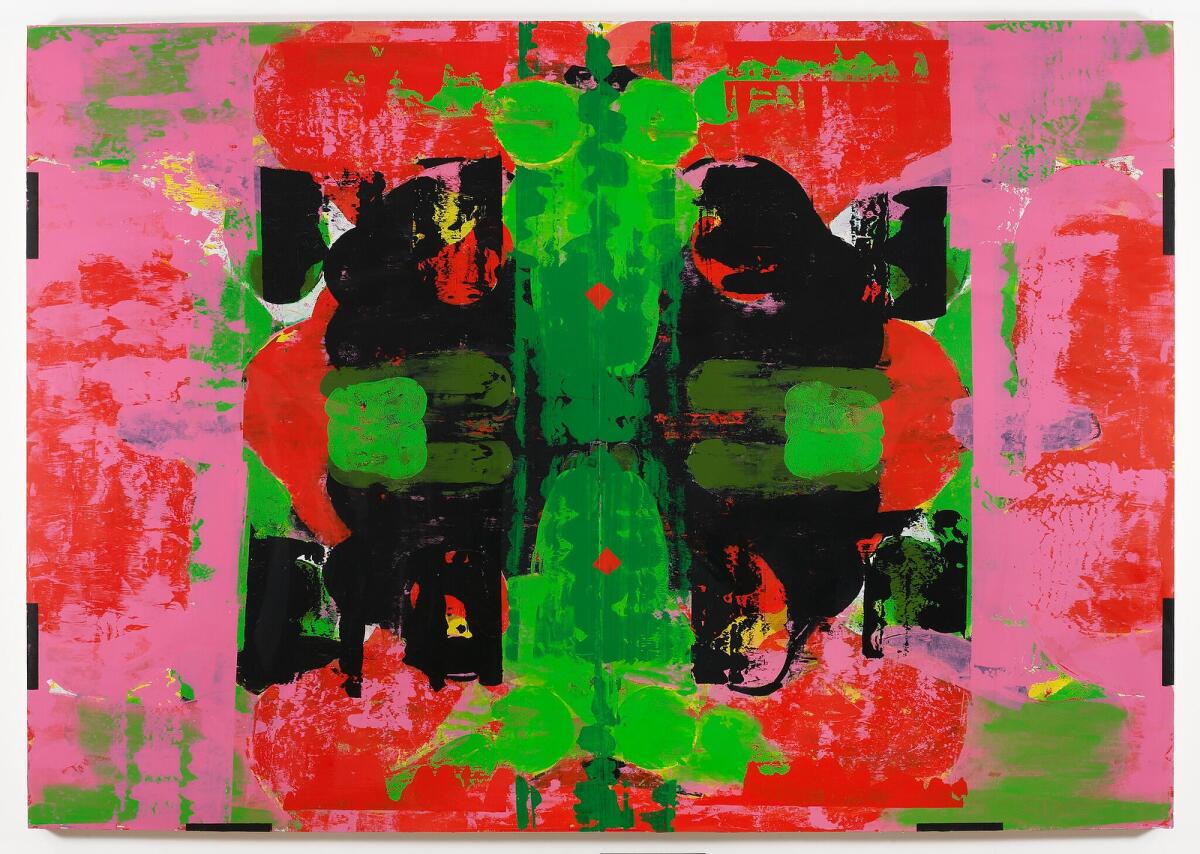Review: Kerry James Marshall’s paintings insist on black self-representation
In 1951, a controversial
Since then, a genre that came to be called black paintings has been a critically contentious subset of American art. Kerry James Marshall, whose exhilarating 35-year retrospective is newly opened at the Museum of Contemporary Art, has turned that conflicted legacy into a powerfully sustained exploration of American history painting.
The path he took to get there is remarkable. Marshall, if I might crib from Cézanne, wanted to make “something solid and lasting like the art in the museums.” That’s no small task for an African American artist who was keenly aware of the dearth of black painters enshrined in institutional art collections.
So Marshall made black paintings.
He didn’t spill black paint like Pollock did for Parsons’ show. He didn’t set black shapes against white ones the way Barnett Newman did, conjuring a metaphor for the dynamic forces of darkness and light. Nor did he create elegant perceptual conundrums out of solid black squares like Ad Reinhardt, nor structural pronouncements about what constitutes a painting, which is what young Frank Stella articulated with a 1958-1960 series of black-and-white striped canvases.
Stella’s precocious black paintings announced the arrival of a major artist. Marshall’s do too, but he is more Goya than abstractionist.
Take a bittersweet group of five monumental paintings that is a stunning centerpiece of the

The compositions are romantic idylls set amid sprawling apartment blocks. Painted in 1994, when the issue of public housing failures was being hotly debated, Marshall’s works are nuanced representations. Bluebirds of happiness flutter past rising clumps of weeds, and graffiti merges with lavish roses. The pose of a crisply dressed young boy or girl might rhyme with the Greco-Roman “Dying Gaul” or a 19th century Courbet or Millet painting of pious field hands.
The way they are painted carries the complex narrative. The big canvases are unstretched and fastened directly to the wall, a 1980s technique used by Leon Golub for brutal images of human torture; it emphasizes the painting’s surface as a metaphorical skin. They are loaded with decorative motifs of the kind prominent in 1970s Pattern and Decoration art, including floral stencils, garlands, ribbons and glitter, as well as spiritual talismans from Afro-Caribbean voodoo.
The paintings project the double-edged meaning of decoration — both a lovely ornament and a wartime badge of honor. Most of all, Marshall’s earthly paradise gardens radiate an insistence on self-representation.
Marshall’s earthly paradise gardens radiate an insistence on self-representation. That insistence is the art’s constant core.
That insistence is the art’s constant core. He stopped making abstract collages in 1979 and has painted representationally ever since, using photographs, magazine pictures and other mass media imagery as tools.
Born in Birmingham, Ala., in 1955, Marshall was 8 when four local children were murdered by the Ku Klux Klan in the notorious 16th Street Baptist Church bombing. The family moved to South Los Angeles, where the young boy soon witnessed the Watts Rebellion. His first direct encounter with painting came the same year at the then-new
Eventually he set his sights on Otis Art Institute (now Otis College of Art and Design), where he would study with Charles White and Betye Saar. In 1993 he began teaching at the University of Illinois, Chicago, and four years later was named a MacArthur Fellow.
Social situations are his essential subject — appropriate for a post-Warhol painter. The terrible gloominess of Goya’s late works — the Spanish master’s own celebrated black paintings — is replaced in the American’s work by something closer to fortitude, although the emotive pathos is shared.

It began in 1980 with the discomfiting “Portrait of the Artist as a Shadow of His Former Self,” one of several paintings that feature a black man dressed in black and before a black background. He’s nearly invisible. Only the whites of his eyes, a gap-tooth grin and a bit of white undershirt stand out. A devastating little work, just 8 by 6½ inches, it is painted on paper in egg tempera.
The medium, as old as ancient Egypt, was a favorite of Jacob Lawrence, cornerstone of the Harlem Renaissance. Marshall was also plainly inspired by Ralph Ellison’s 1952 novel, “Invisible Man,” a first-person narrative of social invisibility. (“People refuse to see me,” Ellison wrote.) At one point, the novel’s anonymous narrator seeks work at a paint factory renowned for its pure white paint. At another, he dons a disguise and is mistaken for a man named Rinehart — in Marshall’s hands becoming a pointed rhyme with Ad Reinhardt, Modernist abstraction’s ultimate black-on-black painter of invisibility.
The little painting, physically not much larger than the book, is also not social protest art, though poetic social criticism overflows from it. The racial derision of black-face minstrelsy runs uncomfortably through the little icon, while the arrow-shaped, elongated white undershirt with a small black button “eye” recalls a different type of disguise — stylized Fang tribal masks, personifications of ancestral power from the equatorial African rain forests of Gabon.

American, European and African art — the self-portrait speaks multiple visual languages at once, drawing on the artist’s own multifarious identity as a painter. Pop culture likewise plays a crucial part, nowhere more incisively than in 1994’s “Self-Portrait of the Artist as a Super Model.”
Marshall, who is heterosexual, adorns himself with pale lipstick and a long blond wig that conjures RuPaul, an icon of African American gay culture. As a vivid representative of black self-representation, RuPaul’s “Supermodel (You Better Work)” had recently stormed the nation’s dance-floors.
Warhol’s own black paintings are also important here. In 1963 the Pop painter produced a group of silkscreen images made from Associated Press photographer Charles Moore’s pictures of young black men, women and children — peaceful protesters — being assaulted by fire-hoses and police attack dogs on the streets of Marshall’s hometown. They were reproduced in newspapers and magazines around the world.
Warhol’s so-called race riot paintings are his mediated version of abstract black paintings. The hue became a signifier.
Two of the show’s most recent works, abstract “Blot” paintings from 2014-15, exploit Warhol’s late-career motif of giant Rorschach ink blots. The psychological test was originally developed to measure thought disorders. Marshall’s blots are composed of large swaths of stamped color, dominated by the red-green-black of the Pan-African flag, all bounded along the edges by fat bands of fleshy Rubens-pink. Black art is framed by pillars of white convention, where only a bit of African color slips through.
The show, which includes 78 works, was organized by Chicago’s Museum of Contemporary Art, New York’s Metropolitan Museum of Art and MOCA, under curators Dieter Roelstraete, Ian Alteveer and Helen Molesworth, respectively. “Kerry James Marshall: Mastry” is the first time in a long time that MOCA’s exhibition program has felt essential. Don’t miss it.

♦ ♦ ♦ ♦ ♦ ♦ ♦ ♦ ♦ ♦
‘Kerry James Marshall: Mastry’
Where: Museum of Contemporary Art, 250 S. Grand Ave., L.A.
When: Through July 3; closed Tuesdays
Information: (213) 626-6222, www.moca.org
christopher.knight@latimes.com
Twitter: @KnightLAT
ALSO
The NEA works. Why does Trump want to destroy it?
Mark Ryden's foray into set design is a fantastical ballet
L.A. in the 1970s: A visual and architectural trove at LAXART
Diego Rivera's Cubist masterpiece arrives at LACMA
The biggest entertainment stories
Get our big stories about Hollywood, film, television, music, arts, culture and more right in your inbox as soon as they publish.
You may occasionally receive promotional content from the Los Angeles Times.








